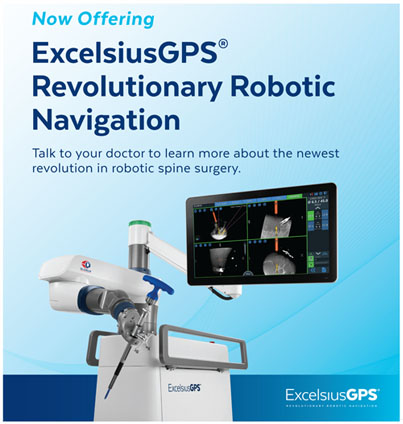MINIMALLY INVASIVE TECHNIQUES
While many patients think that minimally invasive spine surgery (MIS) simply means that the skin incision is smaller, this is only a small aspect of MIS techniques. In fact, smaller skin incision size is typically not a priority during MIS techniques. During MIS spine surgery, the goal is to treat each spine problem through an approach that causes as little native tissue disruption as possible. This requires special instruments and surgical training and techniques. In contrast to traditional spine surgery which strips muscle and ligament from the bone of the spine, or removes an excessive amount of key spine structures, the goal of MIS surgery is to work around the muscles and ligaments, and to preserve vital structures that give stability to the spine. The ultimate goal is a faster recovery, less post-operative pain and bleeding, and better long-term outcomes by preserving as much normal tissue as possible.
Dr. Blaty has a passion for minimally invasive spine surgery. He believes that the most important aspect of MIS techniques is actually surgical decision-making. Performing the least amount of surgery with the most effective outcome is at the foundation of MIS surgery, and this starts with the actual decision concerning what type and how much surgery needs to be performed. After this key step, certain techniques are utilized in the operating room, which requires specific training and education. Next, unique equipment and tools are used during the procedure to allow proper and affective surgical execution. This includes specialized retractors, instruments, and visualization aids.
Synaptive Exoscope – Video
One of these tools used is a unique robotic exoscope called Synaptive. In fact, Dr. Blaty is the only spine surgeon in the Inland Northwest utilizing this robotic exoscope, and only 1 of 3 surgeons in the Northwest states using this for spine surgery. This advanced microscope is called an “exoscope” because it allows the magnification of key anatomic structures onto a large high definition screen, which frees the surgeon from feeling stuck to the eye pieces of a traditional microscope. This not only allows the surgeon to view at extreme angles that no other magnification tool can provide, it offers more advanced clarity and comfort to the surgeon, all of which are essential when performing MIS techniques. In addition, Synaptive utilizes robotic automation during surgery to help maintain accuracy and efficiency.

Another innovative tool which increases accuracy and control in MIS surgery is the Globus ExcelsiusGPS robotic arm. With their passion for cutting edge technology, Northwest Specialty Hospital has acquired this robotic navigation tool. Globus ExcelsiusGPS combines the guided control of a robot, while maintaining the detailed accuracy of surgical navigation when performing spine fusions. This not only allows improved surgical outcomes, but it helps plan surgical incisions and helps minimize tissue damage, which is key to performing minimally invasive spine surgery.
